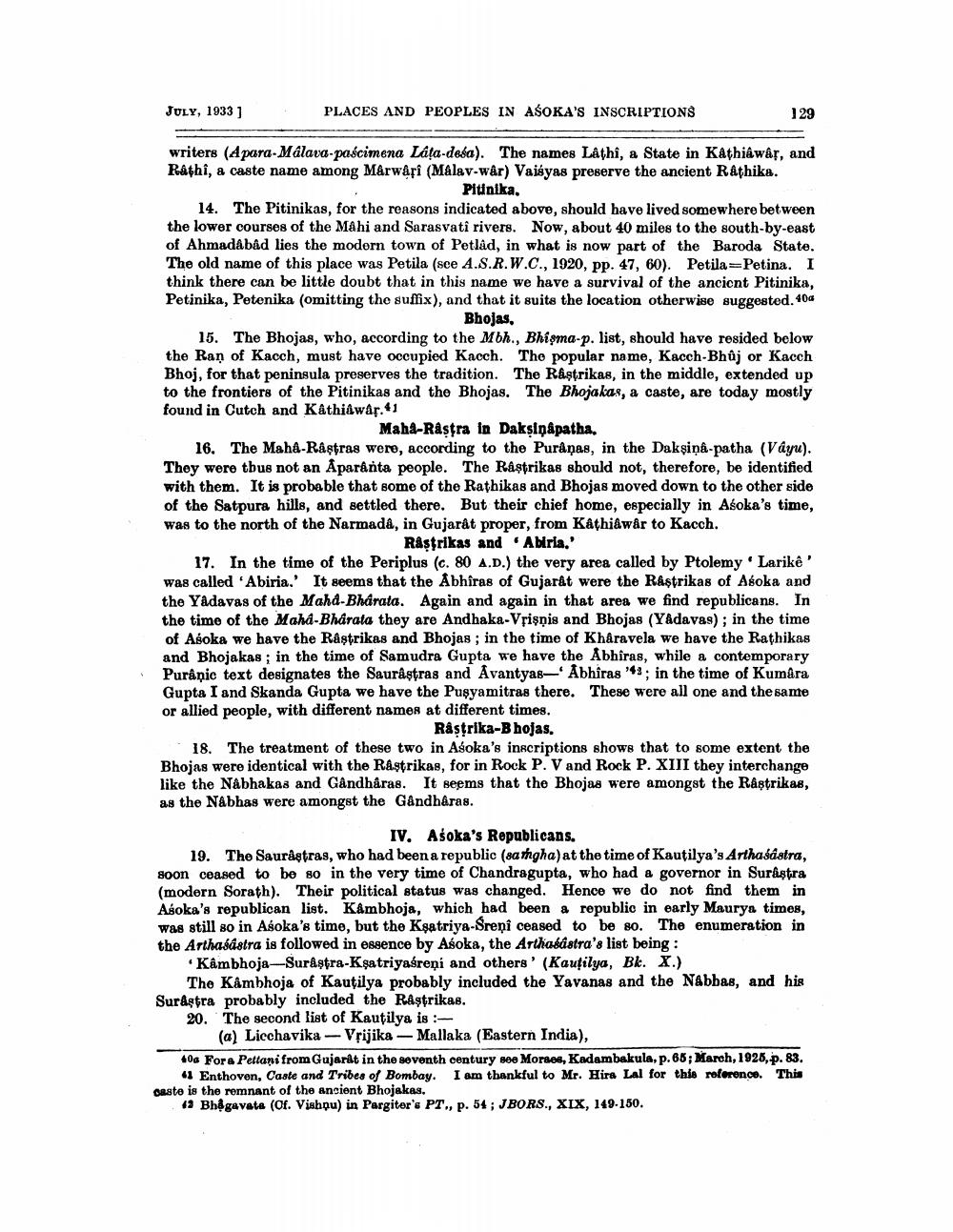________________
JULY, 1933]
PLACES AND PEOPLES IN ASOKA'S INSCRIPTIONS
writers (Apara-Málava-paścimena Lâța-desa). The names Lâthî, a State in Kathiawâr, and Rathi, a caste name among Mârwârî (Mâlav-war) Vaisyas preserve the ancient Râthika. Pitinika.
129
14. The Pitinikas, for the reasons indicated above, should have lived somewhere between the lower courses of the Mahi and Sarasvati rivers. Now, about 40 miles to the south-by-east of Ahmadâbâd lies the modern town of Petlad, in what is now part of the Baroda State. The old name of this place was Petila (see A.S.R.W.C., 1920, pp. 47, 60). Petila Petina. I think there can be little doubt that in this name we have a survival of the ancient Pitinika, Petinika, Petenika (omitting the suffix), and that it suits the location otherwise suggested. 404 Bhojas,
15. The Bhojas, who, according to the Mbh., Bhisma-p. list, should have resided below the Ran of Kacch, must have occupied Kacch. The popular name, Kacch-Bhûj or Kacch Bhoj, for that peninsula preserves the tradition. The Râstrikas, in the middle, extended up to the frontiers of the Pitinikas and the Bhojas. The Bhojakas, a caste, are today mostly found in Cutch and Kathiawâr.41
Maha-Rastra in Daksinapatha.
16. The Mahâ-Râştras were, according to the Puranas, in the Dakṣinâ-patha (Vayu). They were thus not an Aparânta people. The Râstrikas should not, therefore, be identified with them. It is probable that some of the Rathikas and Bhojas moved down to the other side of the Satpura hills, and settled there. But their chief home, especially in Aśoka's time, was to the north of the Narmada, in Gujarât proper, from Kathiawâr to Kacch.
Râștrikas and 'Abiria.'
17. In the time of the Periplus (c. 80 A.D.) the very area called by Ptolemy' Larikê ' was called 'Abiria.' It seems that the Abhîras of Gujarât were the Râştrikas of Asoka and the Yadavas of the Mahd-Bharata. Again and again in that area we find republicans. In the time of the Maha-Bharata they are Andhaka-Vrişņis and Bhojas (Yadavas); in the time of Asoka we have the Râstrikas and Bhojas; in the time of Khâravela we have the Rathikas and Bhojakas; in the time of Samudra Gupta we have the Abhiras, while a contemporary Purâpic text designates the Saurâstras and Avantyas-Abhiras '43; in the time of Kumara Gupta I and Skanda Gupta we have the Pusyamitras there. These were all one and the same or allied people, with different names at different times.
Râṣṭrika-Bhojas.
18. The treatment of these two in Aśoka's inscriptions shows that to some extent the Bhojas were identical with the Râstrikas, for in Rock P. V and Rock P. XIII they interchange like the Nabhakas and Gândhâras. It seems that the Bhojas were amongst the Râstrikas, as the Nabhas were amongst the Gândhâras.
IV. Aśoka's Republicans.
19. The Saurastras, who had been a republic (samgha) at the time of Kautilya's Arthasâstra, soon ceased to be so in the very time of Chandragupta, who had a governor in Surâstra (modern Sorath). Their political status was changed. Hence we do not find them in Aśoka's republican list. Kâmbhoja, which had been a republic in early Maurya times, was still so in Asoka's time, but the Ksatriya-Sreņi ceased to be so. The enumeration in the Arthasástra is followed in essence by Aśoka, the Arthasástra's list being :
Kâmbhoja-Surâstra-Ksatriyaśreņi and others' (Kautilya, Bk. X.)
The Kâmbhoja of Kautilya probably included the Yavanas and the Nabbas, and his Surastra probably included the Rastrikas.
20. The second list of Kautilya is :
(a) Licchavika-Vrijika - Mallaka (Eastern India),
40a Fora Pettani from Gujarat in the seventh century see Moraes, Kadambakula, p. 65; March, 1925, p. 83. 41 Enthoven, Caste and Tribes of Bombay. I am thankful to Mr. Hira Lal for this reference. This
caste is the remnant of the ancient Bhojakas.
42 Bhagavata (Of. Vishnu) in Pargiter's PT., p. 54; JBORS., XIX, 149-150.




